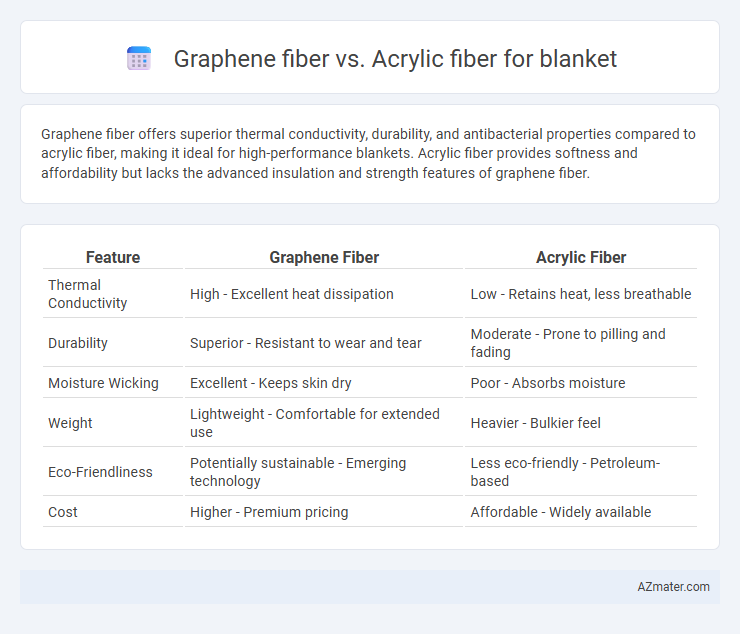Graphene fiber offers superior thermal conductivity, durability, and antibacterial properties compared to acrylic fiber, making it ideal for high-performance blankets. Acrylic fiber provides softness and affordability but lacks the advanced insulation and strength features of graphene fiber.
Table of Comparison
| Feature | Graphene Fiber | Acrylic Fiber |
|---|---|---|
| Thermal Conductivity | High - Excellent heat dissipation | Low - Retains heat, less breathable |
| Durability | Superior - Resistant to wear and tear | Moderate - Prone to pilling and fading |
| Moisture Wicking | Excellent - Keeps skin dry | Poor - Absorbs moisture |
| Weight | Lightweight - Comfortable for extended use | Heavier - Bulkier feel |
| Eco-Friendliness | Potentially sustainable - Emerging technology | Less eco-friendly - Petroleum-based |
| Cost | Higher - Premium pricing | Affordable - Widely available |
Introduction to Graphene Fiber and Acrylic Fiber
Graphene fiber, composed of single-layer carbon atoms arranged in a hexagonal lattice, offers exceptional strength, flexibility, and thermal conductivity, making it ideal for advanced textile applications like blankets. Acrylic fiber, a synthetic polymer derived from polyacrylonitrile, provides lightweight softness, warmth, and moisture resistance, commonly used in affordable and durable blankets. Comparing tensile strength, thermal insulation, and breathability reveals graphene fiber's superior performance for high-tech blankets, while acrylic fiber remains popular for cost-effective warmth and ease of care.
Production Process Comparison
Graphene fiber production involves chemical vapor deposition and exfoliation techniques to create ultra-thin graphene sheets, which are then spun into fibers, emphasizing advanced nanotechnology and high-temperature processing. Acrylic fiber manufacturing relies on the polymerization of acrylonitrile monomers, followed by solution spinning and thermal treating, a well-established chemical and mechanical process. Graphene fiber offers superior strength and thermal conductivity due to its precise atomic structure, while acrylic fiber production is more cost-efficient and scalable for mass blanket manufacturing.
Physical Properties: Strength and Flexibility
Graphene fiber exhibits superior tensile strength compared to acrylic fiber, providing enhanced durability and resistance to wear in blankets. Its exceptional flexibility allows graphene fiber to maintain structural integrity while adapting to various shapes and movements, outperforming the relatively stiffer acrylic fiber. These physical properties make graphene fiber an ideal choice for blankets requiring a balance of strength and flexibility for long-term comfort and resilience.
Thermal Insulation and Temperature Regulation
Graphene fiber outperforms acrylic fiber in thermal insulation due to its exceptional heat retention and dissipation properties, providing superior warmth while preventing overheating. Its high thermal conductivity allows efficient temperature regulation, maintaining comfort across varying conditions, unlike acrylic fiber which traps heat less effectively. Graphene's lightweight and breathable structure enhances moisture-wicking, improving overall thermal management in blankets compared to traditional acrylic fibers.
Breathability and Moisture Wicking
Graphene fiber outperforms acrylic fiber in breathability due to its advanced thermal conductivity, which efficiently regulates body temperature by dispersing heat and moisture. It excels in moisture-wicking capabilities, rapidly absorbing and evaporating sweat to maintain dryness, whereas acrylic fiber tends to trap moisture, leading to discomfort. These properties make graphene fiber blankets ideal for active use and warmer climates, while acrylic fiber suits colder, drier conditions.
Hypoallergenic and Skin Sensitivity Factors
Graphene fiber offers superior hypoallergenic properties compared to acrylic fiber due to its natural antimicrobial and moisture-wicking abilities, reducing the risk of skin irritation and allergies. Acrylic fiber, while soft, can trap heat and moisture, potentially aggravating sensitive skin and causing discomfort. Blankets made from graphene fiber are ideal for individuals with skin sensitivities as they provide breathable, anti-bacterial, and temperature-regulating benefits, promoting healthier skin.
Durability and Longevity in Blankets
Graphene fiber exhibits superior durability and longevity compared to acrylic fiber due to its exceptional tensile strength and resistance to wear and tear, making it ideal for high-performance blankets. The unique molecular structure of graphene enhances thermal regulation and maintains fabric integrity over prolonged use and multiple washes. In contrast, acrylic fibers tend to degrade faster, showing pilling and reduced tensile strength, which limits the blanket's lifespan.
Environmental Impact and Sustainability
Graphene fiber offers superior environmental benefits compared to acrylic fiber due to its high durability and biodegradability, reducing landfill waste and microplastic pollution. Acrylic fiber production relies heavily on petrochemicals and energy-intensive processes, contributing significantly to carbon emissions and environmental degradation. Sustainable blankets made from graphene fiber promote lower ecological footprints by enabling longer product lifespans and easier recycling or composting options.
Cost and Market Availability
Graphene fiber blankets offer superior thermal conductivity and durability but come at a significantly higher cost compared to acrylic fiber options. Acrylic fiber blankets are widely available in the market, providing an affordable, lightweight, and soft alternative suitable for mass production and budget-conscious consumers. While graphene fiber blankets are emerging in niche markets due to advanced properties, their limited production scale results in higher prices and less market penetration than acrylic fiber blankets.
Which Fiber is Better for Blankets?
Graphene fiber offers superior thermal conductivity, moisture-wicking properties, and antibacterial benefits, making it highly effective for blankets that require temperature regulation and odor control. Acrylic fiber, while more affordable and lightweight, lacks the advanced breathability and durability of graphene fiber, often resulting in reduced comfort and longevity in blanket applications. For high-performance blankets prioritizing warmth, hygiene, and durability, graphene fiber is the better choice.

Infographic: Graphene fiber vs Acrylic fiber for Blanket
 azmater.com
azmater.com